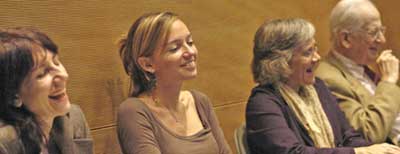Why professors donít dance: Sir Ken Robinson on creativity

Photo by Luigi díAstolofo
Sir Ken Robinson would like us to reconsider how art is studied at university.
“The practice of the arts has largely been marginal in universities, seen as peripheral. If you want to paint—actually do art—you go to an art college. But if you want a degree in art you go to a university where you do art history.
“I’ve always found that interesting. If you went to university to do physics, you did physics in the laboratory. You didn’t spend your time in the library reading about how other people did it,” said Sir Ken Robinson in his speech, “Redesigning the High Table.”
As the keynote speaker at the Creating Space for Art symposium, Sir Robinson presented some provocative and witty observations about creativity and higher education. Author of Out of Our Minds: Learning to be Creative, Robinson is an internationally recognised expert in the development of creativity and innovation.
His 1998 report, All Our Futures: Creativity Culture and Education (commissioned by the Blair government and dubbed the Robinson Report) was published to wide acclaim. Robinson was also a central figure in the peace process in Ireland, providing a strategy for creative and economic developments accepted by all parties.
He has advised many of the world’s leading cultural organizations, international governments and Global 500 companies. UNESCO, the Council of Europe, the Royal Shakespeare Company, and the J. Paul Getty Trust in Los Angeles have sought his advice. In June 2003, Robinson was knighted for his achievements as a leader in creativity, education and the arts.
During his keynote address, he challenged assumptions about creativity. Creativity is not a separate activity from the intellect, but why do so many adults believe they are not creative?
Robinson believes our educational system plays a role in diminishing creativity by promoting learning based solely on a critical and rational approach.
“There is a sense of futility built into our approach to the arts, which is why they are marginalized,” he said.
“We say to children, ‘Don’t do art. You’re not going to be an artist.’ Interestingly, we don’t say, ‘Don’t do math. You’re not going to be a mathematician.’
“Universities are preoccupied with a certain way of thinking and university professors live in their heads, but this is only one form of life. Dancers are also dealing with ideas just as radical but in a different kind of way, with a different kind of knowledge. Why is doing the arts not as intellectually respectable as studying them?”

Photo by Luigi díAstolofo
Robinson suggested we are experiencing an economic and cultural revolution brought on by new technology; universities need to shift from an outdated model of education created in the Age of Enlightenment. In this post-industrial age our educational needs are different and universities must change in order to meet those needs.
“Universities teach many subjects, but one way of thinking. They need to broaden their perception of knowledge. The arts indicate the way we should change. Higher education must rethink its assumptions about intellect and ability in order to organize differently and give people the skills to be more creative.
“We do not know who we are until we know what we can do. That should be the job of education.”
To hear Sir Ken’s entire keynote address, go to: http://fofa.concordia.ca/space.html